DHCP Sim
Refer to the topology below and answer the questions.
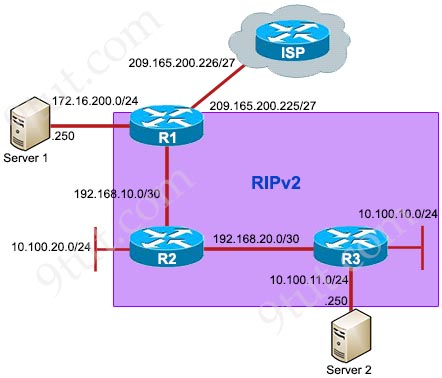
You can download this lab and practice with Packet Tracer at https://www.9tut.com/download/9tut.com_DHCP_Sim.zip (note: In this Packet Tracer file we use FastEthernet instead of Ethernet connections; and interfaces Fa1/0, Fa1/1 instead of interfaces Et0/2, Et0/3)
Question 1
Examine the DHCP configuration between R2 and R3, R2 is configured as the DHCP server and R3 as the client. What is the reason R3 is not receiving the IP address via DHCP?
A. On R3, DHCP is not enabled on the interface that is connected to R2.
B. On R3, the interface that is connected to R2 is in shutdown condition.
C. On R2, the interface that is connected to R3 is in shutdown condition.
D. On R2, the network statement in the DHCP pool configuration is incorrectly configured.
Answer: A
Explanation
First we should check which interface on R3 that is connected to R2 via the “show run” command.
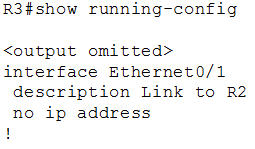
From the description we learn interface E0/1 is connected to R2. Use the “show ip interface brief” command to verify the IP address of this interface.

Therefore we can conclude this interface does not have any IP address and there is no configuration on this interface (except the “description Link to R2” line).
If R3 wants to receive an IP address from R2 via DHCP, interface E0/1 should be configured with the command “ip address dhcp” so the answer “DHCP is not enabled on this interface” is correct.
Question 2
R1 router clock is synchronized with ISP router. R2 is supposed to receive NTP updates from R1. But you observe that R2 clock is not synchronized with R1. What is the reason R2 is not receiving NTP updates from R1?
A. R1 router Ethernet interface that is connected to R2 is placed in shutdown condition.
B. R2 router Ethernet interface that is connected to R1 is placed in shutdown condition.
C. The NTP server command not configured on R2 router.
D. The IP address that is used in the NTP configuration on R2 router is incorrect.
Answer: D
Explanation
First we should verify if the ports connected between R1 and R2 is in “up/up” state with the “show ip interface brief” command on R1 & R2.
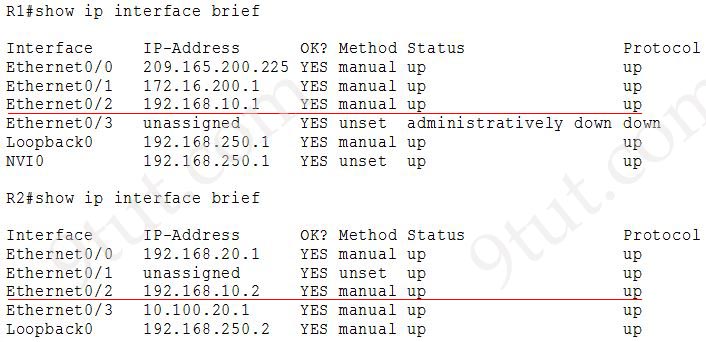
Note: We learn R1 & R2 connect to each other via E0/2 interface because the IP addresses of these interfaces belong to 192.168.10.0/30 subnet. Both of them are “up/up” so the link connecting between R1 & R2 is good.
Next we need to verify the ntp configuration on R2 with the “show running-config” command.

So there is only one command related to NTP configuration on R2 so we need to check if the IP address of 192.168.100.1 is correct or not. But from the “show ip interface brief” command on R1 we don’t see this IP -> This IP address is not correct. It should be 192.168.10.1 (IP address of interface E0/2 of R1), not 192.168.100.1.
Question 3
Why applications that are installed on PC’s in R2 LAN network 10.100.20.0/24 are unable to communicate with Server1?
A. A standard ACL statement that is configured on R1 is blocking the traffic sourced from R2 LAN network.
B. A standard ACL statement that is configured on R1 is blocking the traffic sourced from Server1 network.
C. A standard ACL statement that is configured on R2 is blocking the traffic sourced from Server1 network.
D. A standard ACL statement that is configured on R2 is blocking the traffic sourced from R2 LAN network.
Answer: C
Explanation
We should check if we can ping from R1 to Server 1 or not:

The ping worked well so maybe R1 is good so we should check R2 first. We notice on R2 there is an access-list:
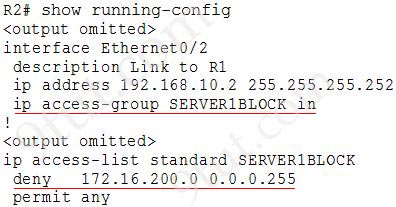
This access-list is applied to E0/2 interface with inbound direction. The purpose of this access-list is to block traffic with source IP address of 172.16.200.0/24 so it will block all traffic sent from Server 1 to us.
Question 4
Users complain that they are unable to reach internet sites. You are troubleshooting internet connectivity problem at main office. Which statement correctly identifies the problem on Router R1?
A. NAT configurations on the interfaces are incorrectly configured.
B. NAT translation statement incorrectly configured.
C. Interesting traffic for NAT ACL is incorrectly configured.
D. Only static NAT translation configured from the server, missing Dynamic NAT or Dynamic NAT overloading for internal networks.
Answer: A
Explanation
If all users cannot access internet then R1 is most likely to cause the problem so we should check it first. From the “show running-config” command we will see:
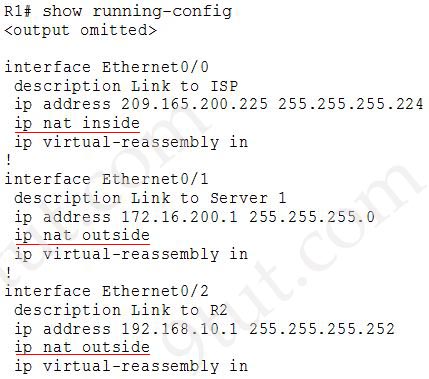
We notice that interface E0/0 (connected to ISP) has been configured as “nat inside” while interfaces E0/1 & E0/2 (connected to our company) have been configured as “nat outside”. This is not correct because “nat inside” should be configured with interfaces connected to our company while “nat outside” should be configured with interfaces connected to the internet. Therefore we can conclude the NAT configuration on these interfaces is not correct.



its not as clear as it is, how are we meant to use show ip interface brief when we dont know what port we’re looking for, also the image does not show us the port numbers so that at least we can know what interface connects to what. All i want to know is that are the ports specified in the exam.
sorry guys was thinking a bit shallow there, the subnet is clearly identified between the interfaces which means that when you use the ‘show ip inter brie’ you know what subnet/interface to look for.
thanks
*PASSED CCNA 910 SCORE, Dump is valid best 20 buck*
Please stop asking to send dump! NO ONE WILL SEND IT the questions are right here to the right I Studied 70% of the questions did not have time for all of them but out of the 70% I studied, I did get about 15 questions in the real exam.
SIM I got were:
ACL 1 and 2
RIP
And OSPF
Guys PLEASE Study all the questions they are to the right specially the “New Questions” STUDY all of them NEW and old and then due the test.
YES they are a lot of questions, but you have do to something can’t get it all easy. STUDY read Memorize whatever.
AND STOP Spamming no one will send you anything!!!!!!!!!!!!!!!!!!!!
Today I got 3 sim:
1. Access List Sim
2. DHCP Sim
3. Access List Sim 2 – (except it was PC-D engaged) the simulation was not accepting the “ip access-list command” so I skipped !!! error was “ip access-list command is not supported by this version of simulator” whatever it means, so I lost more than quarter of hour trying to fix somehow but no chance. The command is listed when you hit the “?” mark but its not working.
@Asha
I take mine in a week, were the questions same? did you pass?
Can anyone forward latest CCNA dumps at hghiorsi at aol dot com. Thank you very much in advance.
Yesterday I got exactly the same sim like Asha:
1. Access List Sim
2. DHCP Sim
3. Access List Sim 2: here we should only use “access-list …” instead of “ip access-list” because there is info that we need to prepare in 3 steps. Also, I have got a problem with delete incorrect declared ACL by using “no access-list …” – so I think the best option is to create a new ACL with another number and on the end assign to proper interface.
A lot of questions you can take from ‘mycertexam.com’ there is more than a thousand questions
and more than 80% was on my exam from the last 400questions put in the .pdf
Very Good Site mycertexam.com. Thanks for sharing
Wish me luck
I’m going To have CCNA 200-125 exam on January 28. I would be glad if you share with me the latest questions. Thanks in advance Please new questions 7
oa554537@gmail (.)com
Got this SIM in my CCNA R&S exam. Cleared it with 957/1000.
Study all the Labs on 9TUT along with Drag n Drops. All the four Labs and 4 Drag n Drops were from here. So perfecting Labs and Drag n Drop will get you very close to clearing your exam.
Hurry up and All the best!!
@ gaurav4u
can u specify more about drag and drop and labs- which one was there , if you remember some of them.. any ipv6 question…?
@ccna…. one drag n drop was about IPv6 like global unicast address matching, unspecified address matching, multicast address matching and link local address matching.
Another one was from PPPoE Client-Server initialization like as:
+ PADI – A packet that is sent with the destination_addr set to the broadcast address. The packet indicates the type of service requested.
+ PADO – A packet that is sent with the destination_addr set to the unicast address of the PPPoE client. The packet contains an offer for the client
+ PADR – A packet that is sent from the PPPoE client with the destination_addr set to the chosen access concentrator. The packet contains a session request from the client
+ PADS – A packet that is sent as confirmation to the client. The packet contains the unique PPPoE session ID
+ PADT – A packet that is sent to terminate the PPPoE session.
sorry…I dont remember each and everyone of them.
The other Labs were:- Access list SIM 2, Access list SIM.
Study all the 9TUT PDF questions on the right carefully. Hope it helps!!
Anyone passed exam in last 2-3 days, which lab was part of exam.
i have on tomorrow
@ Abraham
Did today and got
ACL 1 no changes
ACL 2 different ip add
DHCP no changes